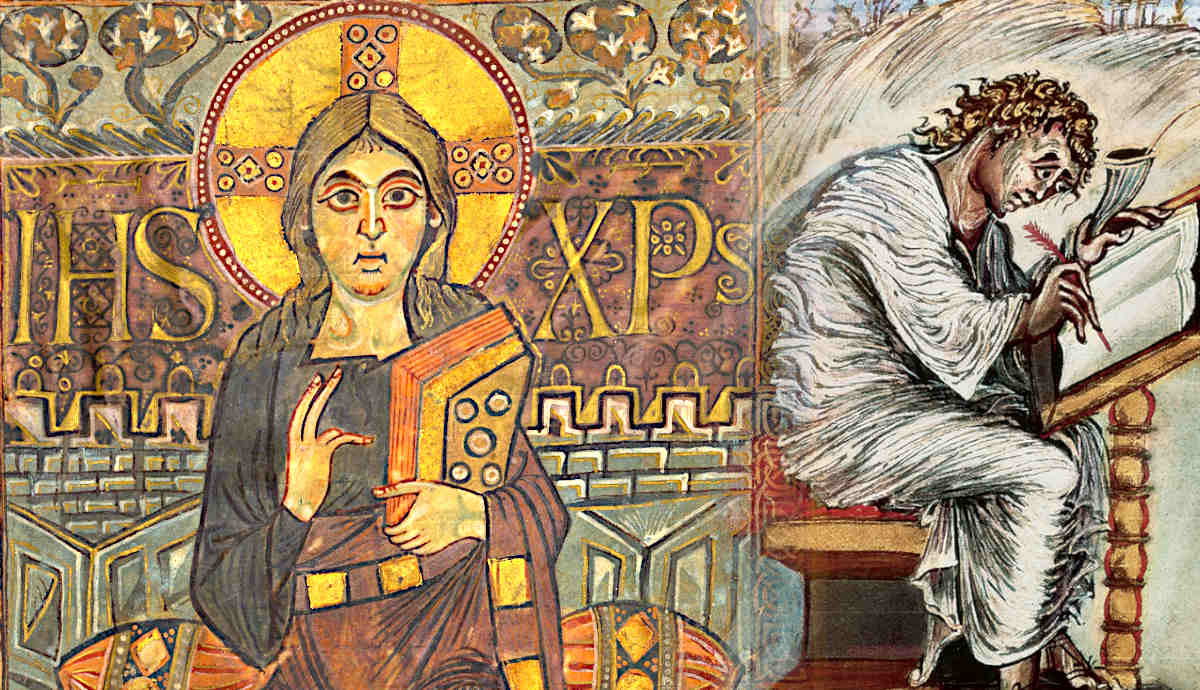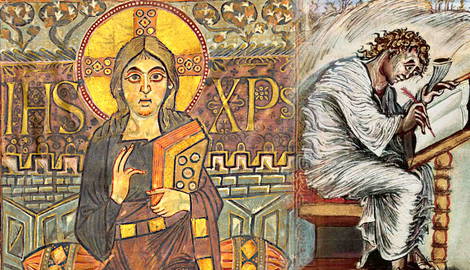
From 750 to 900 AD, Western Europe experienced a spike in the production of illuminated manuscripts. Manuscript illumination during the Middle Ages was the process of decorating hand-written texts with gold or silver, colors, and elaborate designs and miniatures. The illustration of books was meant to be functional as well as decorative. Illuminated initials and painted miniatures marked the beginnings of important text sections and allowed readers to navigate the book easily. The more complex miniatures, including scenes, helped the reader to engage with the text. Other illustrations, similar to monumental painting, elaborate doctrines, record events, or tell stories. Manuscript illumination was at its height in the period of the Carolingian dynasty, where it developed parallel with the revival of classical culture.
Manuscript Illumination Before the Carolingian Dynasty

Diminished after the fall of Rome and Roman culture in Western Europe, manuscript production and preservation were left to a few centers in mainland Europe. Meanwhile, monasteries in northern Europe, especially Ireland, were critical in preserving and illuminating manuscripts. Many Irish monks traveled around England and Western Europe, establishing numerous monasteries. These monasteries’ scriptoria were places where manuscripts were made, copied, and decorated.
The Book of Kells, made at the beginning of the 9th century, is considered a masterpiece of Irish or Insular manuscript illumination. Being never conquered by Rome, Ireland was never under its cultural influence, so its non-Christian traditions remained strong and are reflected in the manuscript’s illumination. Geometric motifs and intertwined strips with floral and animal motifs were adapted from pagan Irish culture. The novelty this manuscript brings to Insular art is the figural representations with a didactic function.

These Insular art characteristics influenced the Merovingian, Carolingian, and Byzantine manuscripts, and some of its elements can still be seen in the manuscript illumination of the late Middle Ages. Within a short period, the Carolingian Dynasty shifted the favor towards Classical styles and applied more of an anthropomorphic, representational, and message-oriented religious and political approach to art as part of the Empire’s Christianization.
Carolingian illustrators adopted Insular art’s large, heavily decorated initials and developed the historiated (decorated with designs representing scenes from the text) decorated initial to produce small narrative scenes. These were seen for the first time toward the end of the period, most notably in the Drogo Sacramentary (850-855).
Carolingian Renaissance & Scribal Culture

The Carolingian Dynasty followed the tradition of Frankish warrior rulers, waging wars and conquering its neighbors, but with a notable change in political ideology. After three centuries, when the last emperor of the Western part of the Roman Empire was deposed, the Pope crowned a new Emperor in 800 CE. The political agenda of the new emperor Charlemagne and his intellectual elite focused on forming a cultural program termed, perhaps erroneously, the Carolingian Renaissance. The program was based on the revival of political institutions and culture of the Roman Empire of Constantine the Great, who was considered an ideal emperor throughout the Middle Ages.
Considering book-making, the change was seen in implementing a uniform script, Carolingian Minuscule, a standardization that initiated the spacing of words with blanks. Another reform was the revival of the use of Latin across the multiethnic Empire. Both changes were meant as tools of uniformity and discipline in the function of the Church and State.
The Carolingian renovatio was a process based on the written word. Its endeavor for authentic texts, biblical, liturgical, and scientific, cannot be divided from the need for decoration. The number of texts created and preserved from the period gives the Carolingian manuscript illumination particular importance.
Characteristics of Carolingian Manuscript Illumination

The amount of preserved texts show an evident change in the style of Carolingian manuscript illumination from its predecessors. Separating itself from the flat, two-dimensional work of Early Christian, Early Byzantine, and Insular manuscript illumination, Carolingian artists sought to restore the third dimension to their works. Classical drawings were used as models for the attempt to make illusions of space. The beginnings of the development are evident in the earlier book illuminations of the Carolingian Dynasty. The portrait of Saint Matthew in the Ebbo Gospels shows the artist’s attempts to show the body as a three-dimensional object in space. The artists used curved lines and shading to create the illusion of the evangelist’s body shape and position. Beneath the footstool, the left leg of Saint Matthew is tucked behind the chair to give a viewer an illusion of perspective.
In both Carolingian manuscript illuminations and ivory carvings, portraits of rulers and evangelists are usually placed in the classical urban setting. The usual architectural elements in which figures are placed are two classical-looking columns bearing an arch, as in the evangelist portraits of the Ada Gospels and Gospels of St. Medard de Soissons. Another notable difference from the earlier Insular art tradition, but in line with the Roman heritage, is the use of purple and gold, related to imperial patronage, evident in the manuscripts related to the court at Aachen.
The Court School of Manuscript Illumination

The center of intellectual and artistic activity of the Empire was the court of Carolingian emperors, starting with Charlemagne and continuing with Louis the Pious and Charles the Bald. The court in Aachen, which played a supervisor role, collected many books used as sources for Carolingian illustration. The so-called court school was crucial for developing and disseminating a unique style of Carolingian manuscript illumination. The focus of artists became the representation of humans according to the norms of classical art. This marked a turning point in Western European art in general.
One of the first manuscripts illuminated in the new classical style was the Godescalc Evangelistary. The images of Christ Enthroned and the four Evangelists take up whole pages of the manuscript, which became a standardized practice from then on. The Godescalc Evangelistary was followed by a series of manuscripts decorated with silver and gold letters, images of the canonic tables, and an occasional individual symbol. Following the development of the Court School style, the Gospels of St. Medard de Soissons carry unique symbolic images such as the Fons Vitae. Translated from Latin as the “Source of Life,” it is a classical circular building from which one draws the life-giving water and is also the image of Heaven.
Different Schools of Manuscript Illumination

The intellectual center of the Empire was at the court of Aachen, but gradually new centers emerged in the 9th century. Carolingian manuscripts were produced in a few monastery-related scriptoria in Reims, Tours, Corbie, and Metz. Each of these workshops developed its own style based on that particular region’s influences.
Reims’ School of manuscript production directly influenced book illumination in the late Medieval period. The Gospel Book of Ebbo (816–835) uses an energetic, streaky style with swift brush strokes that influenced manuscript illumination for decades. The Ebbo Gospels’ portrait of evangelist Matthew is similar to the illustration of the psalmist in the first psalm of the Utrecht Psalter, which also belonged to the Reims school. Its innovative and naturalistic figure line drawings became the most influential innovation of Carolingian art. From the Hautvillers scriptorium near Reims, the Utrecht Psalter went over the channel into England. In Canterbury, its illustrations have been studiously copied in the Harley Psalter.
The Tiberius Psalter, the Arenberg Gospels, and the Eadui Psalter, some of the finest 11th-century English manuscripts, show the sketchy, dynamic style of the Carolingian manuscript.

The schools of manuscript illumination in Tours were prominent during the second half of the 9th century, especially under Abbot Vivian. The period around the middle of the century is considered the golden age of art in Tours, and manuscripts made here influenced the production of manuscripts in the oncoming Middle Ages.
The First Bible of Charles the Bald, or the Vivian Bible, is the most representative example of the school, thanks to its relationship with the emperor. One of the pages represents the portrait of the emperor Charles, corresponding to the image of the biblical King David. The emperor on the throne is shown receiving this Bible in the presence of the imperial guard, abbots, and monks from the monastery. The scene is enveloped in idealized architecture with twisted columns, capitals, and arches. A hand of God at the top points to the emperor, implying that he is chosen by divine providence to lead the Chosen people.
Gold, Gems, & Ivory

The Carolingian Dynasty’s esteem for books is seen in the use of precious materials for their decoration. Some preserved manuscripts show the use of treasure binding, rich coves with jewels set in gold, and carved ivory panels. The need to use precious materials was inspired by the symbolism these materials held. For example, the shine of gold in the Middle Ages was considered the emanation of divine light. The prime Carolingian example of gem-decorated, embossed, golden gospel covers is the Codex Aureus of St. Emmeram. Made for Emperor Charles the Bald, Charlemagne’s grandson, and stylistically related to the front cover of the Lindau Gospels, a contemporary Carolingian gold-smithing masterpiece.
The lines of gems form a cross, dividing the L-shaped surfaces with an encrusted ridge creating a rectangle where the arms of the cross would join. The rectangle is decorated with the figure of Christ the Majesty. A mass of alternating sapphires and emeralds, combined with pearls, all set in sophisticated gold foundation. Intricate filigree fills any spaces left between the gems. Because the gems are raised on miniature platforms, they form a three-dimensional “architecture,” symbolizing the early Christian idea of Heavenly Jerusalem as the ideal city of God. Figures of the surrounding inner fields consist of two groups: the typical portraits of the four Evangelists with their symbols and those representing the narrative scenes from the life of Christ.










